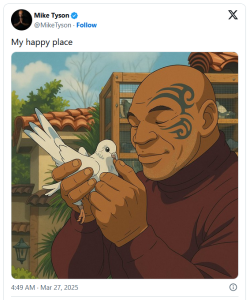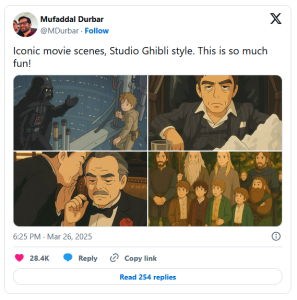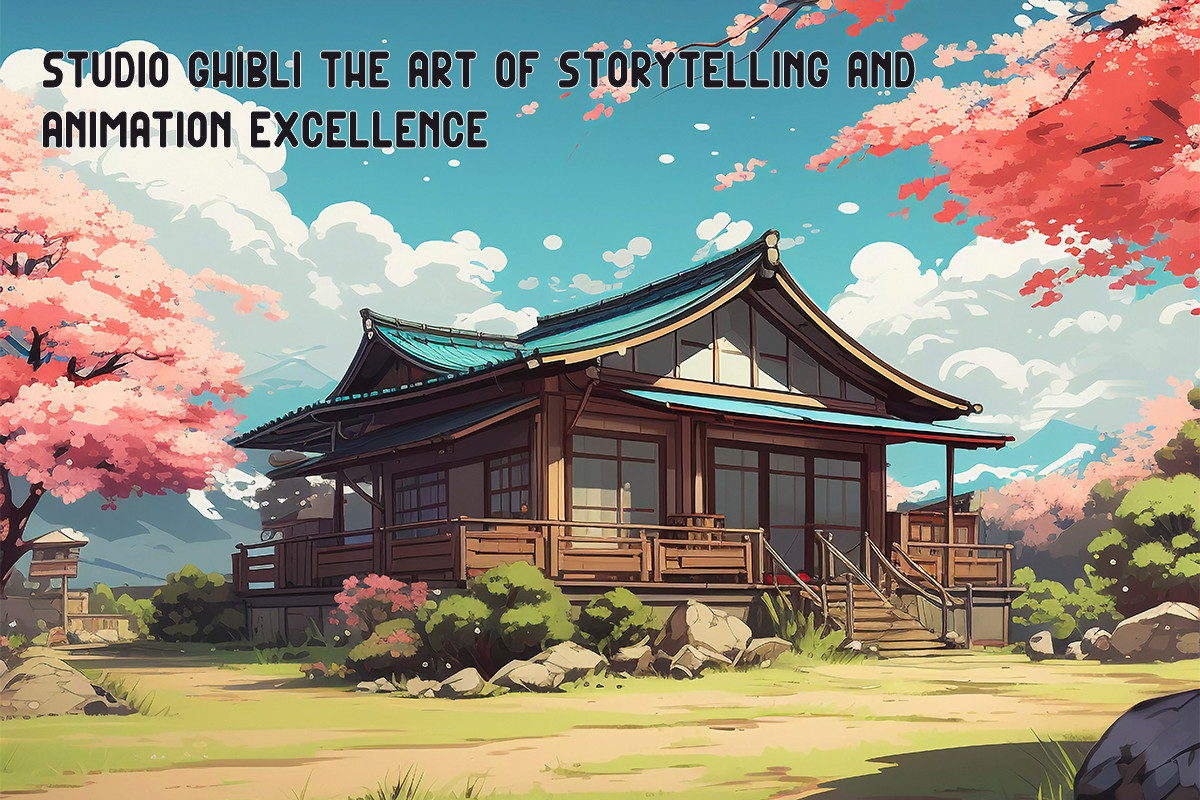Studio Ghibli remains a globally influential animation studio known for its artistic storytelling and iconic characters like Totoro and No Face. While not as commercially dominant as Disney, Ghibli’s impact is vast—contributing to anime series like Fullmetal Alchemist and inspiring global works including Isle of Dogs and The Simpsons.
Despite critical acclaim, the studio faced operational challenges after the retirement of key figures, including co-founder Hayao Miyazaki. In 2014, it nearly ceased production. However, Miyazaki returned in 2017 to direct The Boy and the Heron (2023), which grossed nearly $300 million and won an Academy Award.
In September 2023, Nippon TV acquired Studio Ghibli, securing its future while allowing it to retain creative independence. Miyazaki, now 84, is already working on a new project, reaffirming the studio’s enduring legacy and ongoing evolution.
To commemorate its 40th anniversary, Studio Ghibli, in collaboration with GKIDS and Fathom Entertainment, launched Studio Ghibli Fest 2025. This event brings eight of the studio's acclaimed films back to U.S. theaters, celebrating its enduring legacy and introducing its masterpieces to new audiences.
The launch of OpenAI’s new image generator, powered by GPT-4o, has flooded the internet with Studio Ghibli-inspired images in a trend that, ironically, goes directly against the ethos of Studio Ghibli. Studio Ghibli continues to captivate and inspire, demonstrating that even in the face of industry shifts and internal changes, its commitment to storytelling and artistry remains unwavering.
What is Studio Ghibli?
Studio Ghibli Inc., headquartered in Koganei, Tokyo, is a world-renowned Japanese animation studio. While it is best known for its iconic animated feature films, the studio has also produced a variety of short films, television commercials, and a couple of TV features. The studio’s most recognized symbol is Totoro, the lovable forest spirit from the 1988 film My Neighbor Totoro. Totoro, inspired by a blend of cats and Japanese raccoon dogs (tanuki), has become the face of the company and a cultural icon.
Studio Ghibli was founded on June 15, 1985, by directors Hayao Miyazaki and Isao Takahata, alongside producer Toshio Suzuki, Yasuyoshi Tokuma following the critical success of Nausicaä of the Valley of the Wind (1984), produced by Topcraft. Since then, the studio has also collaborated with video game developers on visual development for several games.
“Many of my movies have strong female leads brave, self-sufficient girls who don’t think twice about fighting for what they believe in.” – Hayao Miyazaki
The studio balances fantasy and reality in ways that connect deeply with global audiences. This case study examines how Studio Ghibli’s philosophy, creative methods, and unique identity helped shape its legacy.
Although Ghibli is now celebrated for producing some of the most acclaimed animated films in cinema history, its beginnings were far from glamorous. Its early works were not initially commercial successes. Some of its now-iconic films were even considered box office disappointments upon release, only later gaining cult status and critical acclaim.
Critique of Earwig and the Witch and Ghibli’s Shift to CGI
With Earwig and the Witch (2020), Studio Ghibli made its first foray into full CGI under Gorō Miyazaki’s direction—a bold move that sparked criticism. The film lacked Ghibli’s trademark elements, including a strong female lead, emotional depth, and creative interpretation. Its overly faithful adaptation and digital style created a visual and narrative disconnect from Ghibli’s traditional charm.
The experiment contradicted the studio’s founding vision of bringing a fresh, emotionally resonant approach to animation. Many felt the film was unpolished and missed the storytelling essence established by Ghibli's founders. Ultimately, this highlighted the studio’s ongoing struggle to balance innovation with authenticity amid leadership changes.
What Went Wrong?
In 2014, Studio Ghibli entered a financial crisis marked by low profit turnover, leading to a temporary production halt. This coincided with the retirement of its founders—Hayao Miyazaki, Isao Takahata, and Toshio Suzuki—creating a leadership and creative void. Gorō Miyazaki, Hayao's son, took over but struggled to maintain the studio’s emotional depth and artistic identity.
The release of Earwig and the Witch (2020), Ghibli’s first 3D animated film, was poorly received for lacking the studio’s signature hand-drawn warmth and strong storytelling. The film’s failure underscored the irreplaceable influence of the founding trio on Ghibli’s global success and unique artistic voice.
Studio Ghibli's Struggle with Integrity and Innovation:
Studio Ghibli is currently grappling with a loss of artistic integrity, a concern even acknowledged by co-founder Hayao Miyazaki. Under Gorō Miyazaki’s leadership, the studio’s pivot to CGI—criticized by Miyazaki himself—has distanced Ghibli from its beloved hand-drawn traditions. The poor reception of Earwig and the Witch reflects this disconnect.
Additionally, Ghibli’s refusal to embrace mainstream commercial strategies, such as franchising and rapid content production, has preserved its artistic values but weakened its financial footing. The studio now faces a critical crossroads: evolve strategically or risk becoming a nostalgic relic instead of a sustainable, forward-looking creative force.
Implementation / Actions Taken
Studio Ghibli’s Post-Retirement Struggles and Financial Challenges:
Hayao Miyazaki’s retirement deeply impacted Studio Ghibli, prompting a production pause and internal restructuring. While blockbuster films like Spirited Away and Howl’s Moving Castle brought in massive global revenue, the studio’s self-imposed cap on merchandising limited its financial growth.
Efforts to diversify through the Ghibli Museum and a theme park launched in 2022 have helped, but recent films under Gorō Miyazaki have performed poorly. The stark decline in critical and commercial success highlights the studio’s ongoing struggle to adapt. Miyazaki’s warning that Ghibli might one day fall apart now seems increasingly relevant as the studio faces uncertainty without clear leadership or a sustainable business strategy.
Methods and Strategic Adaptation
Over the years, Studio Ghibli has taken several steps to diversify its income streams and sustain its creative operations in the face of evolving industry challenges. While the studio’s foundational strength lies in its storytelling and artistry, it has also explored various methods to expand its business model and ensure long-term viability.
Studio Ghibli’s Strategic Responses to Change:
To navigate leadership transitions and evolving market demands, Studio Ghibli implemented several strategies. It identified Yoshifumi Kondō as a potential successor, but his untimely death stalled succession efforts. The studio supported external productions through in-between animation work to stay creatively active.
To expand its global presence, Ghibli made its films available on streaming platforms like Netflix and HBO Max, reaching wider and younger audiences. It also ventured into experiential branding with the Ghibli Museum and the Ghibli Park (opened in 2022), deepening fan engagement.
Following Hayao Miyazaki’s retirement, the studio temporarily paused production to reassess its future, marking a pivotal step toward reorientation and long-term sustainability.
The AI-Generated Studio Ghibli Trend
The launch of OpenAI’s new image generator, powered by GPT-4o, has flooded the internet with Studio Ghibli-inspired images in a trend that, ironically, goes directly against the ethos of Ghibli Studio. Animator Hayao Miyazaki, co-founder of Japanese animation house Studio Ghibli, famously delivered a passionate condemnation of AI that is often quoted by critics of the technology. Now, Ghibli’s “house style,” or at least an imitation of it, is available as a generative filter, and social media timelines have been flooded with cutesy, wide-eyed selfies and iconic photographs transformed into anime images.


Insights
Public Reaction and Uncertainty After Ghibli’s Production Halt:
Studio Ghibli’s temporary production halt raised alarm among fans and critics, sparking fears of permanent closure. In response, co-founder Hayao Miyazaki emerged from retirement to direct The Boy and the Heron, reviving hope but also highlighting concerns about the studio’s future due to aging leadership and lack of succession. The poor reception of recent films like Earwig and the Witch reinforced the perception that Ghibli is struggling to uphold its creative legacy.
Ghibli Museum’s COVID-19 Impact and Recovery Effort:
The Ghibli Museum faced significant setbacks during the COVID-19 pandemic, closing in February 2020 and enduring financial strain due to reduced visitor numbers. To support its upkeep, the city of Mitaka launched a crowdfunding campaign with a goal of ¥10 million, which was surpassed within a day ultimately raising over ¥24 million from 3,000+ domestic donors. However, global fans were unable to contribute due to donation restrictions limited to Japan.
Studio Ghibli’s Leadership Challenges and Creative Integrity:
Studio Ghibli’s strong commitment to artistic integrity has made collaboration and succession difficult. A planned partnership with Mamoru Hosoda during Howl’s Moving Castle fell through due to creative differences, as Hosoda’s modern style clashed with Ghibli’s traditional approach. Yoshifumi Kondō, seen as a promising internal successor after directing Whisper of the Heart, tragically passed away, leaving the studio without a clear path for future leadership.
Ghibli’s Underused Collaborations and Leadership Reliance:
Studio Ghibli has supported other studios through in-between animation work, often without leveraging its brand for visibility or profit. This understated collaboration approach reflects missed opportunities to enhance its presence. Additionally, the studio’s heavy dependence on its founders especially Hayao Miyazaki has exposed a major vulnerability, as it struggles to sustain creative momentum without them. Even strategic efforts like production pauses reveal a lack of long-term leadership planning.
Strengths, Weaknesses, Opportunities, and Threats.
Studio Ghibli’s strengths lie in its global reputation, artistic legacy, and strong intellectual property, all of which have earned it a dedicated following worldwide. However, its over-reliance on its founding members, particularly Hayao Miyazaki, and lack of succession planning have created vulnerabilities or weaknesses in sustaining its legacy. Ghibli's hesitance toward commercialization, while maintaining its artistic integrity, has sometimes hindered its ability to compete in the fast-evolving anime market. Nonetheless, opportunities such as cross-studio collaborations and experiential branding could help expand its reach and relevance. On the other hand, threats like competition from other anime studios and the potential loss of audience relevance in a changing cultural landscape pose ongoing challenges for the studio’s future.
Conclusion
Studio Ghibli’s unique identity rooted in emotional storytelling, strong female protagonists, pacifist themes, and hand-drawn animation has distinguished it from mainstream anime but also created challenges in a fast-paced industry. Despite financial struggles and leadership changes, the studio’s legacy remains tied to founders like Hayao Miyazaki. Balancing artistic integrity with commercial demands continues to be difficult. However, by nurturing new talent, modernizing its outreach, and optimizing operations, Ghibli can evolve and stay relevant for both longtime fans and new audiences in the digital age.
